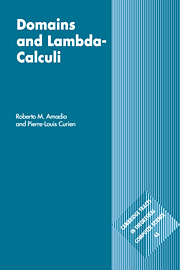Book contents
- Frontmatter
- Contents
- Preface
- Notation
- 1 Continuity and computability
- 2 Syntactic theory of the λ-calculus
- 3 D∞ models and intersection types
- 4 Interpretation of λ-calculi in CCC's
- 5 CCC's of algebraic dcpo's
- 6 The Language PCF
- 7 Domain equations
- 8 Values and computations
- 9 Powerdomains
- 10 Stone duality
- 11 Dependent and second order types
- 12 Stability
- 13 Towards linear logic
- 14 Sequentially
- 15 Domains and realizability
- 16 Functions and processes
- Appendix 1 Summary of recursion theory
- Appendix 2 Summary of category theory
- References and bibliography
- Index
2 - Syntactic theory of the λ-calculus
Published online by Cambridge University Press: 05 November 2011
- Frontmatter
- Contents
- Preface
- Notation
- 1 Continuity and computability
- 2 Syntactic theory of the λ-calculus
- 3 D∞ models and intersection types
- 4 Interpretation of λ-calculi in CCC's
- 5 CCC's of algebraic dcpo's
- 6 The Language PCF
- 7 Domain equations
- 8 Values and computations
- 9 Powerdomains
- 10 Stone duality
- 11 Dependent and second order types
- 12 Stability
- 13 Towards linear logic
- 14 Sequentially
- 15 Domains and realizability
- 16 Functions and processes
- Appendix 1 Summary of recursion theory
- Appendix 2 Summary of category theory
- References and bibliography
- Index
Summary
This chapter introduces the untyped λ-calculus. We establish some of its fundamental theorems, among which we count the syntactic continuity theorem, which offers another indication of the relevance of Scott continuity (cf. section 1.1 and theorem 1.3.1).
The λ-calculus was introduced around 1930 by Church as part of an investigation in the formal foundations of mathematics and logic [Chu41]. The related formalism of combinatory logic had been introduced some years ealier by Schönfinkel and Curry. While the foundational program was later relativized by such results as Gödel's incompleteness theorem, λ-calculus nevertheless provided one of the concurrent formalizations of partial recursive functions. Logical interest in λ-calculus was resumed by Girard's discovery of the second order λ-calculus in the early seventies (see chapter 11).
In computer science, the interest in λ-calculus goes back to Landin [Lan66] and Reynolds [Rey70]. The λ-notation is also important in LISP, designed around 1960 by MacCarthy [Mac60]. These pioneering works have eventually led to the development of functional programming languages like Scheme or ML. In parallel, Scott and Strachey used λ-calculus as a meta-language for the description of the denotational semantics of programming languages. The most comprehensive reference on λ-calculus is [Bar84]. A more introductory textbook is [HS86]. We refer to these books for more historical pointers.
In section 2.1, we present the untyped λ-calculus. The motivation to prove a strong normalization theorem leads us to the simply typed λ-calculus.
- Type
- Chapter
- Information
- Domains and Lambda-Calculi , pp. 22 - 42Publisher: Cambridge University PressPrint publication year: 1998



